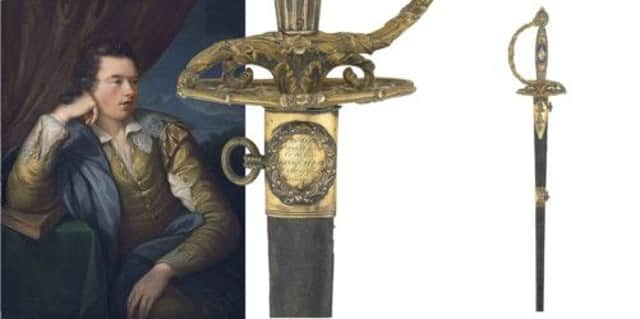Fencibles Scots army sword to be auctioned


The silver-gilt and enamel mounted small-sword, made by a sword maker to the King, was presented to Colonel John Campbell, the Perthshire laird and 4th Earl of Breadalbane, by the 2nd Battalion of 4th Fencible Infantry in 1799 after the regiment saw service in Ireland.
The “Fencibles” were army regiments, originally raised in both Britain and the colonies, for defence against the threat of invasion during the American War of Independence and the French Revolutionary Wars to free regular Army units for offensive operations. The Breadalbane Fencibles were raised in 1793.
Advertisement
Hide AdThe sword is expected to sell for between £10,000 and £15,000 at Bonhams’ sale of Antique Arms and Armour on 27 November.
It carries an inscription which reads: “1799 Presented by the Non Commissioned Officers an Private Soldiers of the 2d Batt 4th Fen.le Infy to their Col. the Earl of Breadal-bane As A Testimony of their Esteem for his Person and Respect for his Noble liberal and Soldierlike conduct while serving with them in Ireland.”
John Campbell, the 4th Earl and 1st Marquis of Breadalbane was educated at Winchester and was 19 years old when he succeeded to the earldom of Breadalbane and Holland in 1782. In 1784 he was elected as one of the 16 Scottish representation Peers to sit in the House of Lords and was also appointed a Fellow of the Royal Society in the same year.
The laird of Taymouth Castle raised the Regiment of Fencibles and served as Lieutenant-Colonel in Ireland, becoming Colonel in 1802, a Major-General in 1809 and Lieutenant-General in 1814.
A spokesman for Bonhams explained: “ In 1806 he was created Baron Breadalbane of Taymouth Castle, Perth which entitled him to a seat in the House of Lords. He was made Earl of Ormelie and Marquess of Breadalbane in 1831 and died at Taymouth Castle three years later”
He added: “The sword was made by John Prosser of Charing Cross, London, appointed Sword cutler and Belt Maker to King George III in 1795 and to George IV in 1827.”
Advertisement
Hide AdThe Breadalbane Fencibles had a total force of 2,300 men, of whom 1,600 were raised from the Breadalbane estate alone. The battalion was sent to Ireland in 1795 where it was stationed until 1802.
SEE ALSO: